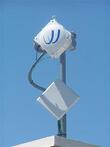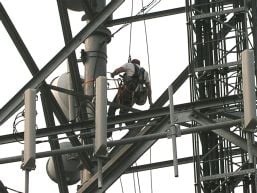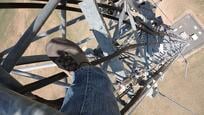The one thing that most people don't understand is the industry background between WiMax backhaul and LTE wireless networks.
WiMax backhaul was originally developed by outdoor wireless backhaul manufactures as a way to provide fixed last mile outdoor wireless bridge connectivity. These were wireless Ethernet bridge players like Alvarion and Proxim (funny how many of the WiMax 802.16 standards, like OFDM, were already found in their existing product lines). Other players like Intel, who has a big stake in IP based technologies, joined the forum. The early intent, of those pushing the WiMax 802.16 standard, was to get the FCC to open up the 3.5GHz space for point to multipoint wireless backhaul. This was to serve the WISP (Wireless Internet Service Provider) market place. Part of the equation was to make mobile devices (like laptops and mobile phones) equipped with WiMax chipsets so they could become an actual subscriber unit (a CPE device) and connect directly to a WiMax point to multipoint wireless base station array.
The one major issue many manufactures of point to multipoint wireless bridges were facing was that they were also providing point to point wireless backhaul in the unlicensed wireless backhaul space and providing outdoor Wi-Fi solutions. Wireless interference is becoming a huge issue in the outdoor Ethernet wireless bridge space when you start using unlicensed wireless bridges (like 5.8GHz wireless backhaul) to serve unlicensed point to multipoint wireless bridges, which then provide Wi-Fi access in unlicensed 2.4GHz (802.11b/g/n) and 5.8GHz (802.11a/n). WiMax equipment if offered in a separate frequency band like 3.5GHz would open up a lot of outdoor wireless backhaul spectrum.
It wasn't until later that WiMax backhaul evolved to the mobile carrier space. Carriers, both fixed wireless and mobile, have adopted WiMax as a technology that they could readily deploy cost effectively to provide the last mile connectivity with greater bandwidth. The other advantage of WiMax backhaul is that IT people (that understand IP networking) can easily take part in outdoor wireless backhaul network deployments because they understand the IP networking background required for WiMax backhaul networks.
LTE was the evolution of the carrier's TDM transport to gain broadband to mobile devices. Many carriers like LTE because it's just an evolved technology of what they are already using. LTE is a natural progression from 2G / 3G and allows fall back. When a mobile device roams out of quality signal strength of an LTE (4G) network it can easily fall back to 3G or lower speed connectivity. Another advantage of LTE over WiMax is that LTE offers less wireless backhaul latency. WiMax backhaul uses a bigger overhead in packets. Many of its supporters are the manufactures that have been part of the mobile market all along.
WiMax backhaul has gained great ground recently worldwide because the equipment is very inexpensive and can be readily deployed for both fixed wireless backhaul and mobile broadband applications. WiMax backhaul equipment can literally be purchased any day of the week form a wireless installation company or wireless distributor. Most outdoor wireless installation companies have equipment on the shelf. Although LTE is a natural progression for carriers that have an existing 2G / 3G networks, countries that do not have a built out cellular network, WiMax backhaul is an easy choice to jump to.
One big difference is that LTE is solely a licensed microwave technology that carriers are utilizing their existing licensed spectrum, where WiMax backhaul is mostly unlicensed (at least in the USA with the exception of a small slice of spectrum in the 3.65GHz space). Many carriers are having the WiMax backhaul manufactures produce outdoor wireless point to multipoint radio equipment that will work in their licensed bands.





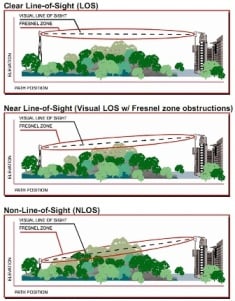
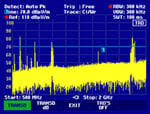
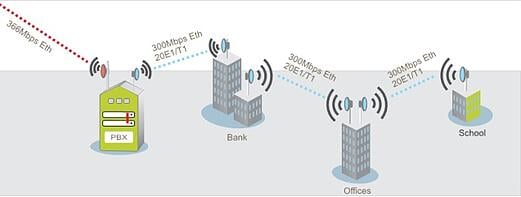

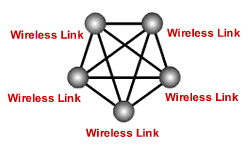
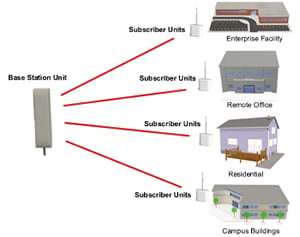 Point to multipoint wireless Ethernet bridge systems are made up of a Base Station Unit (BSU or AP) that can communicate with multiple Subscriber Units (SU's). Many systems can handle over 100 plus SU's per BSU. In most cases the BSU's provide a sector antenna beam pattern (typical is 60 degree, with some systems allowing external antenna configurations for expanding to 90 and 120 degree sector antennas). Multiple BSU's can be installed to create a 360 degree sector (like a typical cell site configuration).
Point to multipoint wireless Ethernet bridge systems are made up of a Base Station Unit (BSU or AP) that can communicate with multiple Subscriber Units (SU's). Many systems can handle over 100 plus SU's per BSU. In most cases the BSU's provide a sector antenna beam pattern (typical is 60 degree, with some systems allowing external antenna configurations for expanding to 90 and 120 degree sector antennas). Multiple BSU's can be installed to create a 360 degree sector (like a typical cell site configuration). 